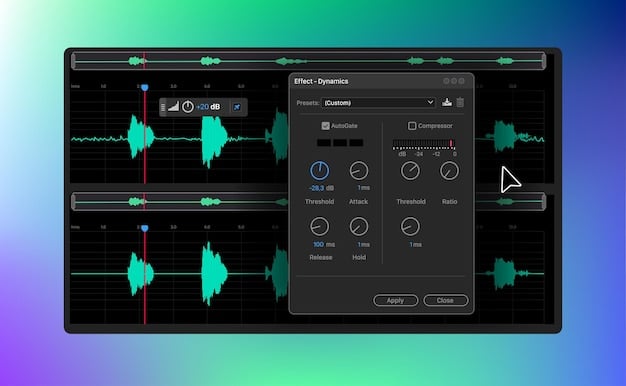Vocal Production Tips: Mastering Pitch, Timing & Creative Effects

Vocal production tips encompass pitch correction techniques, timing adjustments, and innovative effects to refine and enhance vocal performances to professional standards in music production.
In the realm of music production, achieving polished and professional vocals often requires more than just a great performance. Vocal production tips, including precise pitch correction, meticulous timing adjustments, and the creative application of effects, are essential tools for crafting compelling vocal tracks that stand out.
Enhancing Vocals with Pitch Correction
Pitch correction is a fundamental aspect of modern vocal production, allowing producers and engineers to refine the accuracy of vocal performances. This process involves using software or hardware to adjust notes that are slightly out of tune, creating a more polished and professional sound.
Understanding Pitch Correction Tools
Software like Melodyne and Auto-Tune are industry standards for pitch correction. Melodyne offers a more manual approach, allowing detailed manipulation of individual notes, while Auto-Tune provides both automatic and manual correction options.
Effective Pitch Correction Techniques
The key to effective pitch correction is subtlety. Over-correcting can lead to an unnatural, robotic sound. Aim for gentle adjustments that enhance the vocal performance without removing its character.

- Start with a Clean Recording: A well-recorded vocal minimizes the need for extensive pitch correction.
- Use Automation: Automate pitch correction parameters to vary the intensity of correction throughout the song.
- Consider Vocal Style: Adjust settings based on the genre and style of the vocalist.
In conclusion, pitch correction is a powerful tool when used judiciously. By understanding the tools and applying subtle techniques, you can enhance vocal performances without sacrificing their natural feel.
Perfecting Vocal Timing for Impact
Timing is critical in vocal production. How a vocalist places notes and phrases in relation to the beat can significantly impact the song’s groove and overall feel. Adjusting vocal timing is essential for achieving a tight, professional sound.
The Role of Timing in Vocal Delivery
Tightening up vocal timing can enhance the rhythm and energy of a track. Conversely, intentionally loose or syncopated timing can add character and emotion. Understanding the desired effect is key.
Tools and Techniques for Timing Adjustment
DAWs (Digital Audio Workstations) offer various tools for adjusting vocal timing, including warp markers, time stretching, and slicing. These tools allow precise manipulation of vocal phrases without affecting pitch.
Timing adjustments should be made with musicality in mind. Pay attention to the natural phrasing and rhythm of the vocalist. Over-editing can lead to a stiff, unnatural performance. Consider the overall goal of the timing adjustments, whether it’s to tighten up the groove or enhance the emotional impact.

Creative Vocal Effects: Shaping Your Sound
Vocal effects are essential for shaping the sound and adding character to vocal performances. From subtle enhancements to dramatic transformations, effects can elevate vocals and help them stand out in a mix.
Essential Vocal Effects
Reverb, delay, compression, and EQ are fundamental effects in vocal production. Reverb adds space and depth, delay creates echoes and rhythmic patterns, compression controls dynamics, and EQ shapes the tonal balance.
Experimenting with Modulation Effects
Chorus, flanger, and phaser effects can add movement and texture to vocals. These modulation effects create a swirling, shimmering sound that can be subtle or pronounced, depending on the settings.
- Reverb: Use different types of reverb (plate, hall, spring) for different moods.
- Delay: Experiment with different delay times and feedback settings.
- Compression: Use gentle compression to even out dynamics and more aggressive compression for a punchy sound.
In conclusion, creative vocal effects offer endless possibilities for shaping sound. By experimenting with effects and understanding their nuances, you can craft vocals that are both unique and compelling, adding depth and character to any track.
Advanced Vocal Production Techniques
Advanced vocal production techniques involve more sophisticated methods of enhancing and manipulating vocal performances. These techniques can add depth, texture, and uniqueness to vocal tracks, setting them apart from standard productions.
Vocal Stacking and Layering
Vocal stacking involves recording multiple takes of the same vocal part and layering them together. This technique can create a fuller, richer sound. Each layer should be slightly different to avoid phasing issues.
The Power of Vocal Harmonies
Harmonies add depth and complexity to vocal arrangements. Experiment with different intervals and voicings to create interesting harmonic textures. Use subtle pitch correction on harmonies to ensure they blend well with the lead vocal.
Consider the goal of each technique. Vocal stacking can add weight and presence to a lead vocal, while creative harmonies can evoke emotion and add complexity. Adjust your approach based on the needs of the song.
Mixing Vocals: Achieving Clarity and Balance
Mixing vocals is a crucial step in the production process, ensuring that vocals sit well within the mix and are both clear and balanced. Effective mixing techniques can elevate the vocal performance and enhance the overall listening experience. This is one of the key vocal production tips almost every expert uses.
EQ and Compression for Vocal Clarity
EQ is used to shape the tonal balance of the vocal, removing unwanted frequencies and enhancing desirable ones. Compression controls the dynamic range, making the vocal more consistent in volume.
Balancing Vocals with Other Instruments
The key to a good mix is balance. Ensure that the vocals are not too loud or too quiet in relation to the other instruments. Use panning to create space and separation.
- EQ: Cut unnecessary low frequencies to reduce muddiness.
- Compression: Use a moderate ratio for gentle control.
- Panning: Place vocals in the center and other elements around them.
Mixing vocals requires careful attention to detail and a good understanding of EQ, compression, and panning. By applying these techniques judiciously, you can achieve a mix that is both clear and balanced.
Mastering Vocal Production: Tips for a Polished Sound
Mastering vocal production involves the final touches that ensure a polished and professional sound. This stage includes subtle enhancements that bring out the best in the vocal performance and ensure it translates well across different playback systems.
Final Polish: Automation and Effects
Automation can be used to add subtle variations in volume, EQ, and effects throughout the song. This adds movement and interest to the vocal performance. Subtle effects, such as a touch of saturation or tape emulation, can add warmth and character.
Ensuring Consistency Across Playback Systems
Check the vocal mix on different speakers, headphones, and playback systems to ensure it sounds consistent and balanced. Pay attention to the low end, ensuring it is not too boomy or thin.
Pay attention to detail and listen critically on different playback systems. This will help you catch any issues and ensure that the vocal performance sounds its best.
Common Pitfalls in Vocal Production and How to Avoid Them
Vocal production, while powerful, can also be fraught with common pitfalls that can detract from the overall quality of the vocal track. Recognizing these pitfalls and knowing how to avoid them is crucial for achieving professional results.
Over-Correcting Pitch
Over-correcting pitch can lead to an unnatural, robotic sound. Use pitch correction tools subtly and preserve the natural character of the vocal performance. A natural-sounding vocal will always be more engaging than a perfectly-in-tune, lifeless one.
Excessive Compression
Excessive compression can flatten the dynamics of the vocal, making it sound lifeless and fatiguing to listen to. Start with a moderate compression ratio and adjust to taste. Always listen for the natural peaks and valleys in the performance.
Avoid these pitfalls and approach vocal production with a focus on balance and subtlety. This will help you create vocal tracks that are both polished and natural-sounding, elevating the overall quality of your productions.
| Key Point | Brief Description |
|---|---|
| 🎤 Pitch Correction | Refine vocal accuracy using software like Melodyne or Auto-Tune subtly. |
| ⏱️ Timing Adjustment | Tighten or loosen vocal timing to enhance rhythm and emotional impact. |
| 🎛️ Creative Effects | Use effects like reverb, delay, and modulation to add depth and character. |
| ⚖️ Mixing Vocals | Balance vocals with instruments using EQ, compression, and panning for clarity. |
Vocal Production FAQs
▼
Pitch correction is the process of adjusting the intonation of a vocal performance to correct any inaccuracies. It’s used to achieve a polished, professional sound by ensuring notes are in tune.
▼
Use tools like warp markers in your DAW to subtly adjust the timing of vocal phrases. Focus on aligning key words and rhythmic elements with the beat to enhance the groove.
▼
Reverb, delay, compression, and EQ are fundamental vocal effects. Reverb adds space, delay creates echoes, compression manages dynamics, and EQ shapes the tonal balance.
▼
Vocal stacking involves recording multiple takes of the same vocal part and layering them. Aim for slight variations in each take to create a fuller, richer sound without phasing issues.
▼
Use pitch correction tools subtly and conservatively. Focus on gentle adjustments to maintain the natural character of the vocal performance while addressing noticeable inaccuracies.
Conclusion
Mastering vocal production tips is essential for achieving polished and professional vocal tracks. By understanding and applying techniques such as pitch correction, timing adjustment, and creative effects, producers and engineers can elevate vocal performances to new heights, ensuring they stand out in any mix.





